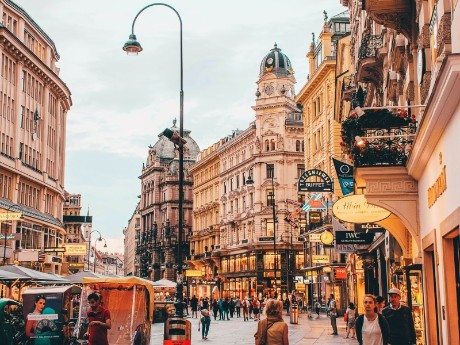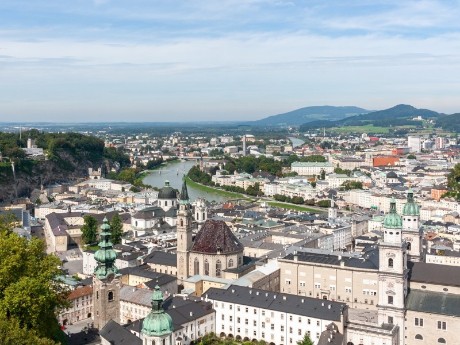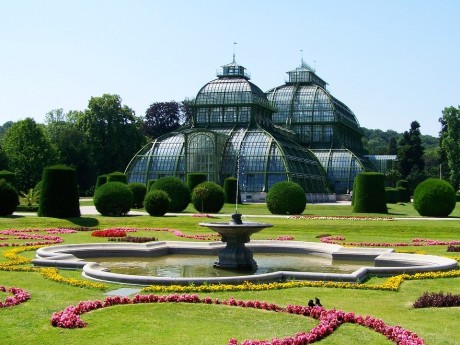Austria: Salzburg and Vienna
Embark on a journey to see two beautiful cities in Austria. Begin in Vienna, iconic for the Schönbrunn Palace where you can explore opulent rooms, stroll through magnificent gardens, and learn about the history of the Habsburg monarchy. Moreover, the baroque styled St. Stephen's Cathedral is an architectural marvel, standing at 500 feet, while the 800 year old Belvedere Palace offers some of Austria's most valuable art collections.
Read more
Embark on a journey to see two beautiful cities in Austria. Begin in Vienna, iconic for the Schönbrunn Palace where you can explore opulent rooms, stroll through magnificent gardens, and learn about the history of the Habsburg monarchy. Moreover, the baroque styled St. Stephen's Cathedral is an architectural marvel, standing at 500 feet, while the 800 year old Belvedere Palace offers some of Austria's most valuable art collections. If possible, catch a show at the renowned Vienna Opera House or simply visit to be mesmerized at the stunning architecture. After taking in the beauty of Vienna, rent a car and drive to Salzburg, famously known as Mozart’s hometown. See panoramic city views at Fortress Hohensalzburg and visit the Mirabell Palace which offers the beautiful marble Marble Hall and the Mirabell Gardens. Hellbrunn Palace, Salzburg Cathedral and Residenzplatz are among other historic places to see. Whether wandering through Vienna's imperial palaces or soaking in the musical heritage of Salzburg, Austria promises a journey filled with history, culture, and natural beauty. Waterviews strives to offer accommodation options within walking distance of water and/or in an area of touristic interest. Our prices include taxes (but excludes local tourist taxes). Customize your trip to your personal preferences with optional activities (hit the “Add Activities’’) or change hotels, etc. Contact us for customization at no extra cost at: Service@waterviewstravel.com
<b
Destinations
- Vienna
- Salzburg
Itinerary
Vienna

Austria’s capital is pure elegance; Imperial Palaces sit alongside sprawling museums, grand coffee houses and concert halls, all built in a delightful mixture of Baroque, medieval and contemporary architectural styles. The city has a long history of artistic and musical importance which it still carries today, and visitors can spend days getting lost in the UNESCO listed Altstadt, enjoying the music from world-renowned classical artists and sampling delicious cakes and Viennese culinary specialities.
Read more
Austria’s capital is pure elegance; Imperial Palaces sit alongside sprawling museums, grand coffee houses and concert halls, all built in a delightful mixture of Baroque, medieval and contemporary architectural styles. The city has a long history of artistic and musical importance which it still carries today, and visitors can spend days getting lost in the UNESCO listed Altstadt, enjoying the music from world-renowned classical artists and sampling delicious cakes and Viennese culinary specialities.
Additional Information
History
The low-lying Danube plain in and around what is now Vienna has had a human population since at least the late Paleolithic (see Prehistoric Europe); one of the city's most famous artifacts, the 24,000-year-old Venus of Willendorf, now in Vienna's Natural History Museum, was found nearby. Vienna's own recorded history began with the Romans, who founded it in the 1st century CE as Vindobona, one of a line of Roman defensive outposts against Germanic tribes. Vindobona's central garrison was on the site of what is now the Hoher Markt (the "High Market" so-called because of its relative height over the Danube), and you can still see astounding excavations of its foundations there today.
Given its prestige, Vienna hosted the Habsburg court for several centuries, first as the Imperial seat of the Holy Roman Empire, then the capital of the Austrian Empire, and later of the Austro-Hungarian Empire, which finally fell in 1918 with the abdication of the last Emperor Karl I. The court tremendously influenced the culture that exists here even today: Vienna's residents are often overly formal, with small doses of courtliness, polite forms of address, and formal dress attire. One distinguishable paradox of the quirky city is that its residents can be equally modern and progressive as they are extremely old-fashioned.
The empires also served to make Vienna a very metropolitan city at an early time, and especially so through the years of industrialization and fall of the Austro-Hungarian Empire at the turn of the 20th century. Imperial Austria and Austro-Hungary were multilingual, multi-ethnic empires and although the German speakers normally played the dominant role in Vienna there has long been ethnic and linguistic diversity in the city. Proof of Jews in the city dates back to 10th century. After World War II many of the city's minorities had been exiled or killed and much of the city lay in ruin. When Austria was given sovereignty after the post World War II occupation, it was eventually established that Austria would be neutral and not join the Eastern Bloc. So the city became more isolated from its previous ties to its Slavic and Hungarian neighbors; the east of Austria was surrounded by the Iron Curtain. Vienna had gone from being the well-established metropolitan city of Central Europe to the capital of a small, predominately German-speaking nation of states with strong regional identities. But when the Iron Curtain came down in the early 1990s an influx of immigrants and Yugoslav refugees came to Vienna. In 1995 Austria joined the EU and her neighbors to the east joined in 2004. In addition, Vienna became a business hub between Eastern and Western Europe due to its imperial past and location, with many multinational companies having offices and facilities in the city and many Austrian companies investing in Eastern Europe. These series of events helped the city rise from the ashes. Vienna once more sits at the heart rather than at the edge of Central Europe, with connections that had been severed for decades slowly but surely being re-established.
Since the formation of the first Austrian Republic and the first mayoral election 1919, the Social Democratic Party of Austria has had the majority of representatives on the common council and controlled the mayoral seat. During the early years, the socialist Red Vienna ("Rote Wien") revolutionized the city, improving the extreme conditions that the industrial revolution and rapid urbanization had created. Most famously the city built many housing projects (housing estates or "Gemeindebauten"), and they also began to offer many social services and made improvements across the board in quality of life. The public housing that was built at that time is now famous for its distinctive style. To this day the city continues to build public housing and about a third of the city's residents live in it, some 600,000 people! Through this high percentage, the quality, and the integration of public housing across the city have kept it from becoming as stigmatized as in most cities. The Viennese are used to having the city government in their lives, and of course have a love-hate relationship with it. Vienna functions on its own as a federal state in the Austrian system (along with 8 other states) and the sense of local pride and home is more of being Viennese than being Austrian, many say.
Vienna was the host city for the Eurovision Song Contest, Europe's largest live televised event, in May 2015.
Culture
Traditional Vienna is but one of the many façades of this city; the historic center, a UNESCO world heritage site, is sometimes begrudgingly compared to an open-air museum. But Vienna is also a dynamic young city, famous for its (electronic) music scene with independent labels, cult-status underground record stores, a vibrant Monday through Sunday club scene, multitudes of street performers, and a government that seems overly obsessed with complicated paperwork. However, people are willing to go out of their way or bend the rules a little if they feel they can do someone a favor.
The Viennese have a singular fascination with death, hence the popularity of the Zentralfriedhof (Central Cemetery), where there are more graves than living residents in Vienna, as a strolling location and of Schrammelmusik - highly sentimental music with lyrics pertaining to death. Old-fashioned Sterbevereine (funeral insurance societies-literally translated "death clubs") provide members with the opportunity to save up for a nice funeral throughout the course of their lives. This service does not exist solely to save their children the hassle and expense - it is considered absolutely mandatory to provide for an adequate burial. Vienna even has the "Bestattungsmuseum", a museum devoted to coffins and mortuary science. The country’s morbid obsession may be correlated with its higher suicide rate when compared with the rest of Europe. Here too, the socialist Vienna has its hand, the city also offers a socialized undertaking service, with hearses branded in the same department of public works logo as the subway cars, and a link to the transit-planner on their website.
Vienna is also famous for its coffee culture. "Let's have a coffee" is a very commonly heard phrase, because despite incursions by Starbucks and Italian-style espresso bars, the Kaffeehauskultur is still the traditional way to drink a cup of coffee, read the newspaper, meet friends, or fall in love.
Orientation
Addresses in the Vienna articles are written with the street name following the district name. Badgasse 26, Alsergrund is Badgasse #26 in the 9th district. One can always tell what district you are in by the first number on street signs. Districts can also be made into a postal code by substituting the XX in 1XX0 Vienna (0X for districts below 10), for instance 1090 Vienna for the 9th district and 1200 the 20th, and are sometimes referred to as such.
Common points of reference are often used in Vienna in addition to districts, most notably public transportation stops. Reference to U1/U4 Schwedenplatz or Schwedenplatz (U1, U4) means that something is near to the Schwedenplatz stop on the underground lines U1 and U4. Normally if the place is not directly at the subway stop you can ask around and find it easily.
The Vienna Tourist Board operates information and booking booths at the airport Arrival Hall, 07:00-23:00 and the in the center at 1., Albertinaplatz/Maysedergasse (9:00-19:00). Information and free maps are also available from the ÖBB InfoPoints and offices at train stations.
The city has a very centralized layout radiating from the historic first district with the Stephansdom and Stephansplatz at the centre of a bullseye. It is encircled by the Ringstraße (Ring Road), a grand boulevard. Districts 2-9 are considered the core districts and are gathered within the Gürtel (Belt Road), which encircles the core districts as an outer ring concentric to the Ring around the first district, with the notable exception of Leopoldstadt (2). The outer 14 districts are largely less urban but are equally as diverse.
Climate
Spring starts sometime in late March, normally it is very brief and summer-like weather sets in before the trees have had time to grow back their leaves.
Summer in Vienna is usually warm. Weather in June is moderate and sunny with a light summer windy breeze. In July and August, there are some hot and humid days where it reaches 35°C (95°F), but overall, summer in Vienna is pleasant.
Autumn starts around September, although an "Indian Summer" with warm and sunny days often occurs that month and it gets colder as it approaches November. A main disadvantage of the Viennese climate is that it is rather windy and usually overcast during these months.
Winter in Vienna can be just above 0°C (32°F) and drizzling for days on end, or just below with dustings of snow that manage to melt again quickly. There is the occasional cold snap where it will stay below freezing for a week or two at a time. Due to Vienna's relative easterly position in the Central European Time Zone its daylight hours (if it's not too gray outside entirely) are relatively early during the winter.
Sunday closures
The vast majority of shops, restaurants, and cafes are closed on Sunday. The main exceptions are shops and restaurants located in train stations, flea markets, a few small family-run outfits, and tourist oriented souvenir shops. Many museums and other attractions are also closed, and the public transportation system runs less frequently and keeps different hours. If you plan to visit anything on Sunday, be sure to check if it will be open. Besides visiting museums and churches, a stroll through the Prater or a hike in the Wienerwald are good Sunday activities.
© Sourced from Wikivoyage
Salzburg

Salzburg paints a quintessential image of Austria; its UNESCO listed fairytale-like Altstadt filled with Baroque and medieval architecture, its setting on the Salzach River and the hilltop Hohensalzburg Fortress with its mountainous backdrop all play a part in the magical atmosphere of the city. Crowds flock to Salzburg due to its musical legacies of The Sound of Music and Mozart, and the city has more than its fair share of artistic and cultural highlights as well as an excellent culinary scene.
Read more
Salzburg paints a quintessential image of Austria; its UNESCO listed fairytale-like Altstadt filled with Baroque and medieval architecture, its setting on the Salzach River and the hilltop Hohensalzburg Fortress with its mountainous backdrop all play a part in the magical atmosphere of the city. Crowds flock to Salzburg due to its musical legacies of The Sound of Music and Mozart, and the city has more than its fair share of artistic and cultural highlights as well as an excellent culinary scene.
Additional Information
Salzburg is the fourth-largest city in Austria (after Vienna, Graz and Linz) and the capital of the federal state of Salzburg. Its "Old Town", with its world famous baroque architecture, is one of the best-preserved city centers in the German-speaking world and was listed as a UNESCO World Heritage Site in 1997.
Origins of name
The name Salzburg, literally "Salt Castle", is derived from the barges carrying salt on the Salzach river, which were subject to a toll in the 8th century.
Early history and medieval period
Traces of human settlements dating to the Neolithic Age and later a Celt camp have been found in the area. Starting from 15 BC, the small communities were grouped into a single town which was named by the Romans as Juvavum. Little remains of the city from this period.
The Festung Hohensalzburg, the city's fortress, was built in 1077 and expanded in the following centuries. Independence from Bavaria was secured in the late 14th century.
Independent state
Salzburg was the capital of an independent state from the early 14th century until 1805. It was ruled by prince-archbishops, who became rich by the salt mines located in the south of the city. This led to the architectural gem you see today, as materials and architects were imported from Italy and other European countries. This is also why, compared to other Austrian cities, sacral monuments surpass the few secular buildings in every respect. The prince-archbishops were forced to give up their political powers during the French occupation in 1805, when Napoleon Bonaparte introduced the concept of separation of Church and State in all the occupied territories.
© Sourced from Wikivoyage





